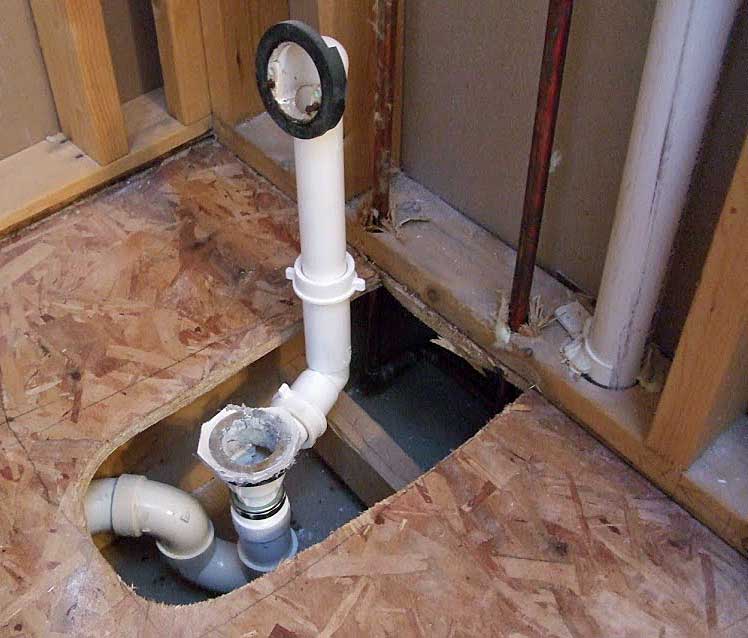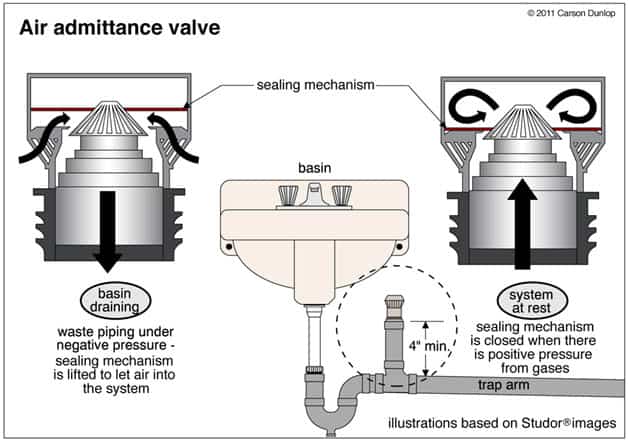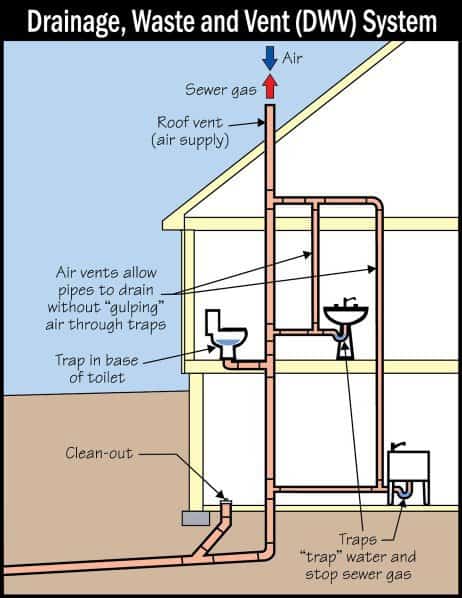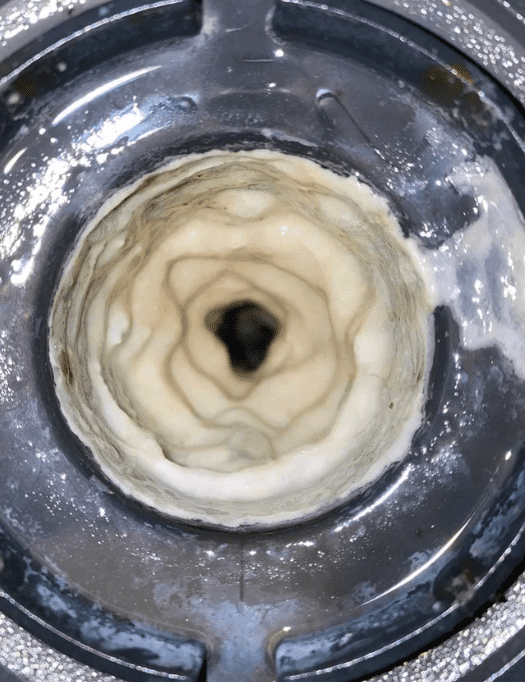Do you often hear a gurgling (“blub blub” or “glug glug“) noise from the bathtub or shower drain when you flush a toilet?
You aren’t sure if this air bubble noise issue is severe enough to warrant spending $70 to $120 per hour (the average cost of a plumber before trip fees and materials)
This issue is usually caused by a blocked drain or a vent pipe. Sometimes, it can indicate a damaged sewer main line or a P-trap problem—leading to toxic gas backup or water overflowing from the toilet. Other times it may be Air Admittance Valve (AAV) issue or blockage in the septic system.
But how do I differentiate? And more importantly, how do I fix it without calling a plumber? What if my home has a septic tank, not a city sewer line?
Not an issue! I’ll share everything I’ve learned from several licensed plumbers while running a full-service construction company in Phoenix, AZ.
Let’s dive right into it!
- How to Diagnose the Noises
- 1. The Problem: The Shower Drain P-trap is Missing, Cracked, or Empty
- 2. The Fix: Inspect or Replace the Shower Drain P-trap
- 3. The Problem: The Air Admittance Valve (Auto-vent) is Not Installed or Faulty
- 4. The Fix: Install or Replace the Air Admittance Valve (Auto-vent)
- 5. The Problem: The Plumbing Vents Pipes/Stack are Inadequate, Missing, or Clogged
- 6. The Fix: Unclog or Install Sufficient Air Vents
- 7. The Problem: The Bathtub Drain Pipe is Clogged
- 8. The Fix: How to Unclog a Bathtub/Shower Drain Pipe Effectively
- 9. The Problem: The Sewer Line is Clogged
- 10. The Problem: The Private Septic Tank has Blockages, clogged filters, or is Full
- 11. The Fix: Pump/Empty the Septic Tank and Unclog Filters
- Nothings Works and Shower Drain Still Gurgles? Here's What to do When Everything Fails
How to Diagnose the Noises
The most important question is to ask:
Does the gurgling affect only a particular shower/bathtub or multiple plumbing fixtures?
A specific tub drain is clogged if the blockage affects a particular toilet or shower.
If you don’t find any clogs, it’s possible that the Air Admittance Valve (AAV, if you have one) or the P-trap needs to be replaced.
If your home has a sewer system:
If all the shower/tub or multiple plumbing fixtures (like the sink drain or the washing machine) in your home gurgle, this could indicate a main sewer line block. You might also experience water draining slowly or water backups in the shower, bathtub, or sink.
If your home has a Septic system:
You could experience backups if your septic tank is full. The United States Environment Protection Agency (EPA) recommends emptying the tank every two to three years by mechanical pumping. Also, we have noticed quite a few cases of gurgling when something clogs the filter in the septic tank.
No matter your situation, we’ll guide you step-by-step to get help rid of this “glug glug” noise. You can use the above tips to narrow down the issue and skip to the relevant fixes below.
1. The Problem: The Shower Drain P-trap is Missing, Cracked, or Empty

What is a P-trap: A P-trap is a u-shaped bent waste pipe that connects the bathtub’s drain to the sewer system or septic tank. It also stops dangerous sewer gases like hydrogen sulfide and methane from entering your home.
How to identify if this is your problem: The tub is likely not vented if you have an older S-trap. When you flush the toilet, it tries to draw the air from the nearby sink causing the gurgling noise. If you have a modern P-trap: Along with the noise, you might also sometimes experience water backflow, or the water in the tub takes longer than before to flow down. Also, the P-trap is likely clogged if your tub smells like rotten eggs.
2. The Fix: Inspect or Replace the Shower Drain P-trap
Ensure your tub drain has a P-trap: Shine a light down the drain to see if water stands in the pipe. It might not be installed if you see just the pipe and no water.
Refill the P-trap: The P-trap can dry if you haven’t used the bathtub or nearby plumbing fixtures in a few days. A dry P-trap might be one of the reasons behind the nasty sewer smells. In this case, simply flushing the toilets and pouring water down the drain and bathtub should do the trick.
Ensure there are no cracks: A P-trap can leak at the connecting nut, or the pipe can develop cracks. Tighten the bolts and try using plumbing tape to fix the leak. If it’s apparent it cannot be fixed, replace it.
Here’s how to effectively clean your P-trap:
- Turn off the water faucet and place a bucket directly under the p-trap.
- Hold the connecting pipe and unscrew the p-trap nut using a plier to remove it.
- Depending on how full your P-trap is, some water will spill out. The bucket we placed in step 1 will collect the water.
- Clean the trap using a bottle brush
- After cleaning, line up the pipe correctly and screw the trap into its place.
- Turn on the faucet to check for leaks. Tighten the bolts until there are no leaks.
If your P-trap is underground or inside your wall, you need to call a professional.
3. The Problem: The Air Admittance Valve (Auto-vent) is Not Installed or Faulty

What is an Air Admittance Valve, AKA Studor valve: This one-way mechanical valve installed after the trap helps address the negative air pressure when a fixture is drained (like flushing a toilet.) Sometimes, if you can’t (or don’t want to) vent through the roof line, you can use it for proper ventilation and prevent sewage gases from entering your home. It is typically used at an island sink or to avoid roof penetrations.
How to identify if this is your problem: If your tub drains very slowly, even when you’ve ensured there are no clogs, installing an AAV can help dissipate negative pressure caused by toilet flushing—thus eliminating the loud gurgling noises from the drain. If you have an existing AAV, it may be time to replace it.
4. The Fix: Install or Replace the Air Admittance Valve (Auto-vent)
While most states allow the use of AAVs, some state and local building rules prohibit its use. Check with your local Authority Having Jurisdiction (AHJ) to find the most up-to-date information.

Kurt Joyce
Here’s how to install or replace an AAV, also called a cheater valve:
- Disconnect and remove the trap bend using pliers.
- AAVs are typically placed between the P-trap of a fixture and the drain line. Ensure to install it at least 4″ above the horizontal branch.
- Measure, cut, and chamfer the pipe accordingly.
- Install the assembly and attach the drain pipe.
5. The Problem: The Plumbing Vents Pipes/Stack are Inadequate, Missing, or Clogged

What is the vent stack? The vent pipe is a vertical pipe located on your home’s roof. Its advantages are two-fold:
- It regulates the airflow in your plumbing system. The drain pipes cannot move the waste and water without proper air circulation.
- It removes sewer gases. Sometimes, these foul and dangerous sewer gases can return to your home. If you can smell strange gases, it can be a tell-tell sign of an issue with the vent pipe.
What causes the air vent to block?
- Common things that block the vent pipe are leaves, debris, insects, and sometimes—dead mice and nests (yes, we’ve seen the last two!)
- Your shower drain might gurgle when the toilet is flushed, especially in cold weather, because in colder climates, the water condenses into the ice near the air vent—thus blocking it.
- Sometimes, a contractor can forget to remove the caps on the vent pipes after running a pressure test or something.
- There are structural issues, such as the wrong slope of the horizontal venting system in the attic.
6. The Fix: Unclog or Install Sufficient Air Vents
If unclogging the tub doesn’t work, the issue is likely a clogged vent pipe.
How to clear a blocked vent pipe?
- Clearing a blocked vent pipe will require you to get on the roof—so make sure you’re comfortable doing that (or call a handyperson/plumber)
- If you’ve multiple vent stacks, look for the one near the bathroom where the bubbling or gurgling happens. If you can see only one pipe, multiple vents have been combined into one.
- Remove any leaves or debris you may find at the surface.
- Use a thin flashlight to look further down. If you see any obstructions, such as dead mice or insects, try removing them with a wire hanger.
- Pour down the water in the vent using a garden hose.
- Consider installing a screen over your vent pipe. Keeping foreign objects out of your vent pipe prevents costly plumbing repairs.
7. The Problem: The Bathtub Drain Pipe is Clogged

What causes a clog in my drain? The most common causes of a shower drain clog are human hairs, soap scum, and hard water. Hairs can not only restrict water flow but also stick to grime and soap scum to worsen the problem. The soap can mix with the hard water to form a soap scum that attaches to the inner sides of the drain. If your area has hard water, calcium and iron can stick to the sides of the drain.
8. The Fix: How to Unclog a Bathtub/Shower Drain Pipe Effectively
8.1 Easy Fixes: Remove Visible Obstructions Using a Coat Hanger, Hot Water, or a mixture of Baking Soda With Vinegar
Remove the drain cover. Pour hot water around the edges. This can help dissolve the build-up of soap scum. If you’ve PVC pipes, skip this step as the heat can damage PVC pipes. Remove the soap scum and hairs. You can use a flashlight if nothing is visible.
We hear you asking:
Can I use a wire coat hanger to clean the drain? Yes, you can use a coat hanger if the clog is near the surface of the drain. We’ve seen some plumbers’ advice against it since it can get stuck, worsening the clog. But in our experience, it’s alright to do so as long as you’re careful about it.
Alternatively, you can also try mixing 1⁄3 cup of baking soda with 1⁄3 cup of vinegar and flush it down the drain. Cover the drain and let it sit for 15 to 30 minutes. Pour boiling water down the drain. The bubbling reaction from this chemical reaction can sometimes help break up the grease or oil residues.
8.2. Plunge the Bathtub Drain
A plunger is a simple plumbing tool that uses suction and pressure to remove a blockage in the drain.
Before plunging:
Use a wet rag or duct tape to block the overflow opening on the front wall of the bathtub. To do this, you may need to remove the cover on the overflow tube.
Here’s why:
If you don’t seal the drains, the air pressure can escape through other drains—making our plunging process less effective.
How to (correctly) use a plunger to plunge a shower, bathtub, or toilet drain:
- As mentioned above, ensure you’ve sealed the overflow using a wet rag or duct tape.
- Cover the drain opening completely with the plunger. The tighter the seal, the better. Try using a silicone lubricant if you don’t get a good seal.
- Fill enough water in the tub till the plunger cup is covered.
- Thrust the plunger up and down. Repeat this process a few times.
- If the water drains away, the unclog has been successful.
We don’t recommend using chemical cleaners because they can cause damage to the plumbing, mix with the water supply, and be a hazard for us and the environment. To top that, they aren’t even very effective in removing clogs.

Kurt Joyce
8.3. Plunging Doesn’t Work? Try Unclogging With a Drain Snake Auger (Plumbing Snake)
What is a Drain Snake?
A drain snake is a flexible auger that can help remove clogs when a plunger doesn’t work. The coiled-shaped metal wire can break up obstructions to enable water to flow again.
To unclog a tub drain, you’ll need a hand auger. In our experience, it’s not a good idea to run a hand auger through toilets for two reasons:
- Toilets often have a larger drain pipe than most plumbing fixtures—leading to a tangled snake. Most plumbers recommend using a 1/4″ wire for less than 2 inches of the drain pipe.
- The wire can damage your porcelain bowl.
To unclog a toilet drain, use a closet/toilet auger. The hook-shaped metal tubing makes it easier to insert the auger into the toilet.
How to Unclog With a Drain Snake or a Closet Auger
Most augers can reach up to 25 feet—so you can easily find one for your needs. Crank the auger until you experience some form of resistance. Gently push the auger back and forth a few times to break down the clog. Then, remove the auger and run the water for about 5 minutes to flush the clog.
9. The Problem: The Sewer Line is Clogged
Your main sewer line may be clogged. A tell-tale sign of this is multiple plumbing fixtures in your home are bubbling, you hear a strange gas smell, or if there’s water backup. At this point, we recommend calling a professional sewer repair company. They can use hydro-jetting to shoot up to 4,000 PSI of water through the pipes—enough to break down tree roots or anything clogging the sewer line.
10. The Problem: The Private Septic Tank has Blockages, clogged filters, or is Full
If the line from (or to) the septic tank to a drain field is partially blocked, it might work usually until there’s suddenly increased water usage.
Does your shower, tub, or sink gurgle only when it’s laundry day, when it’s raining, or when you have guests over? A partially clogged waste piping can certainly be the issue. This can also lead to sewage smells or backups into your home.
11. The Fix: Pump/Empty the Septic Tank and Unclog Filters
The United States Environment Protection Agency (EPA) recommends emptying the tank every two to three years by mechanical pumping. Also, we have noticed quite a few cases of tub gurgling when something clogs the septic tank filter. Pumping the tank and cleaning the tank filter should do the trick.
Also, check for:
- Blockages in the line from your home/building to the septic tank.
- Solids blocking the septic tank inlet or outlet.
- Clogs in the septic tank filter.
Nothings Works and Shower Drain Still Gurgles? Here’s What to do When Everything Fails
In our decade-long experience, the above tips should solve the issue in most cases. If it doesn’t, you may have an edge case. Here are some additional tips:
- Check for vacuum breaker at drains: Sometimes, old plumbing fixtures with no proper ventilation can have a vacuum breaker one-way valve. A malfunctioning or broken valve can also lead to this noise.
- Improperly installed or no ventilation: If your home is new, it’s possible that the vent has not been installed or is incorrectly installed.
- Inadequate ventilation: If you don’t see a plumbing vent stack pipe over your home where the bathroom is located, they might have insufficient or improperly installed ventilation. It’s also possible that the plumbing fixture is too far away from the plumbing stack.
- Cast iron pipes can restrict water flow more easily: If your home has old cast iron pipe plumbing, it may be more prone to clogs. It can quickly corrode and build up more minerals and waste. Consider replacing it with ABS or PVC pipes and increasing the diameter of the pipes.
- If everything fails, it’s time to call a professional licensed plumber. They can perform a visual inspection and use a drain camera to investigate the issue further.

